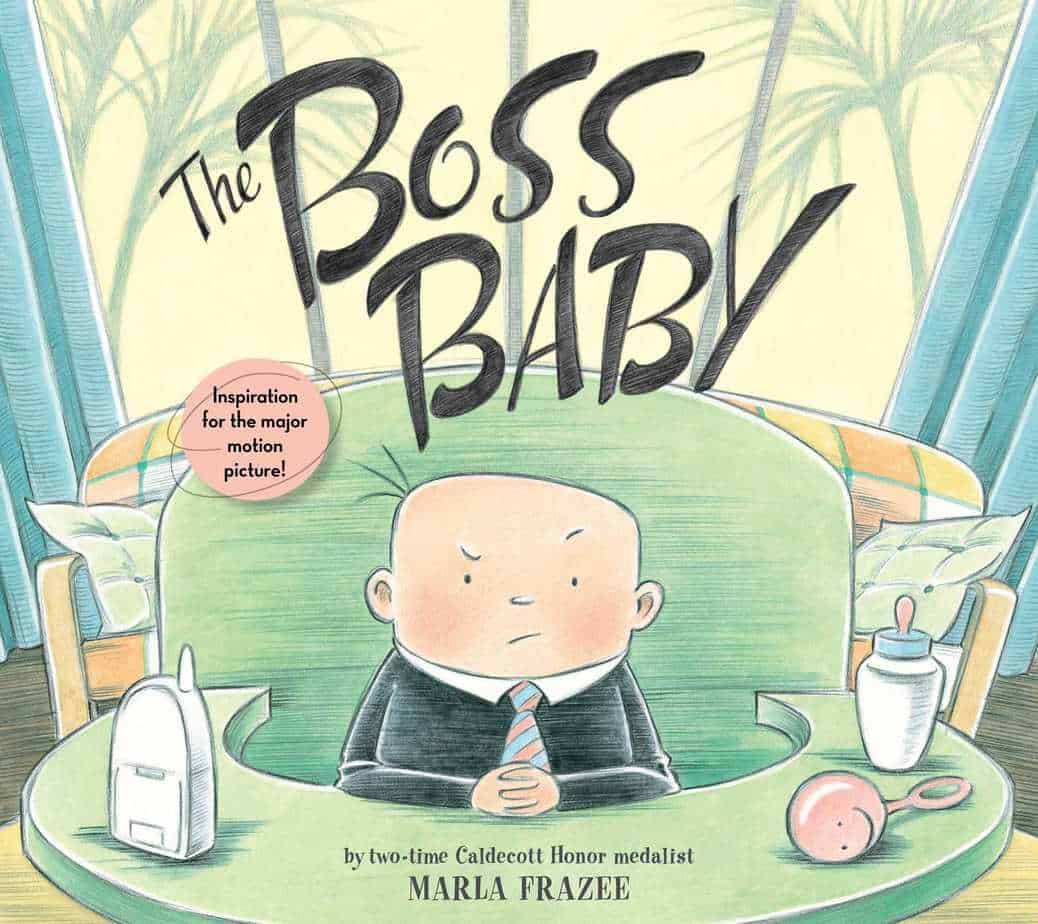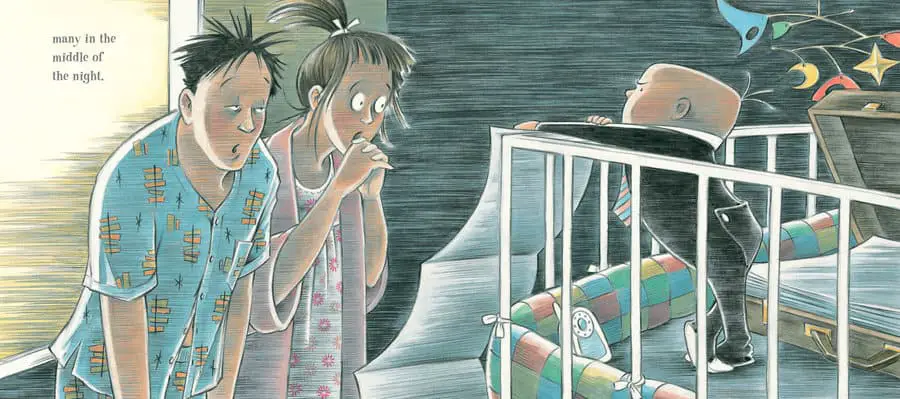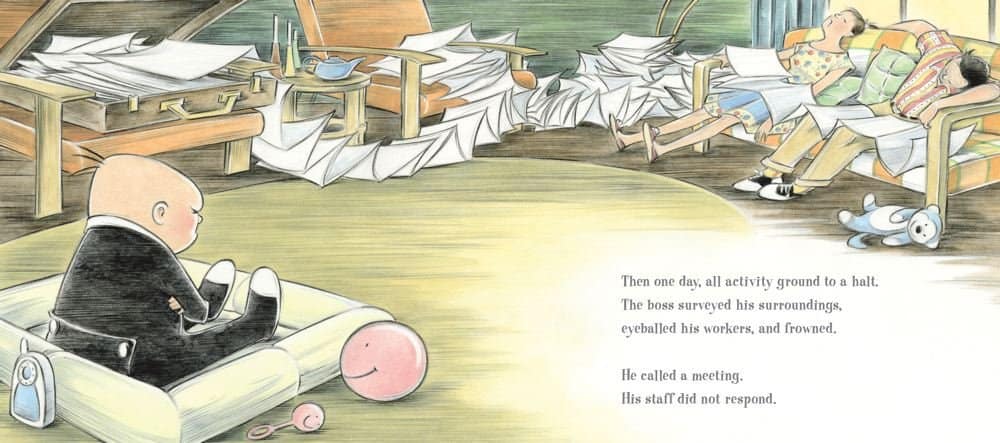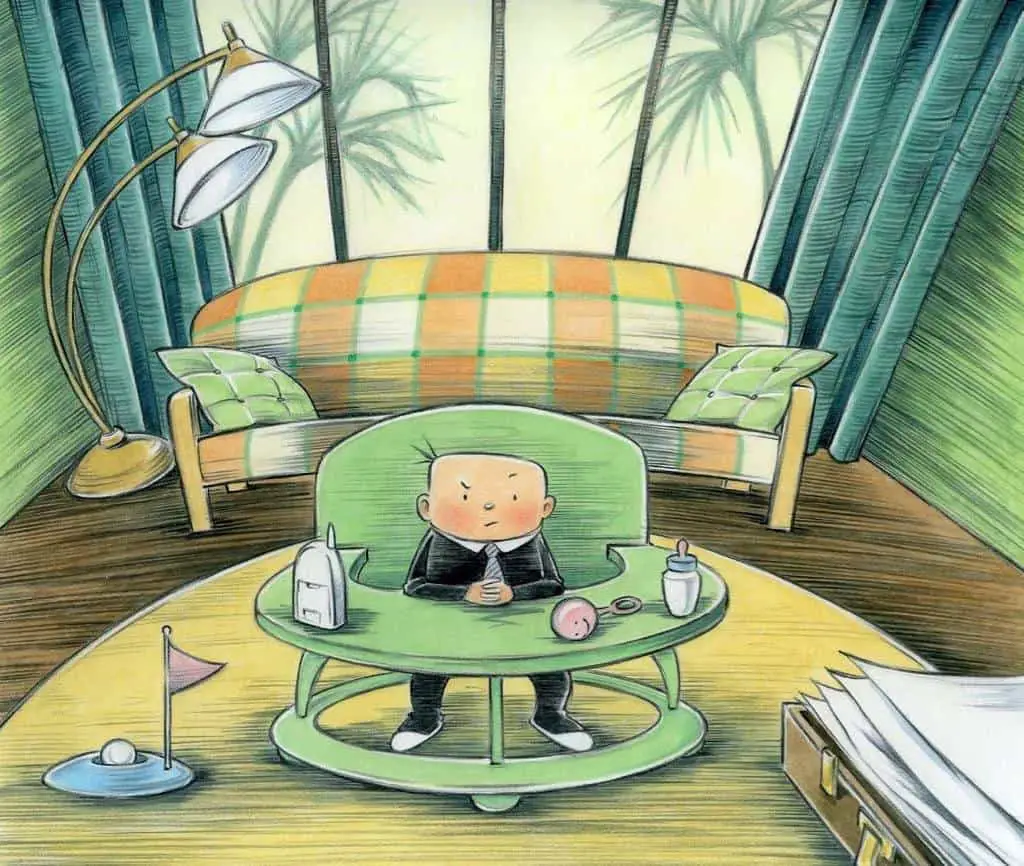Boss Baby, written and illustrated by Marla Frazee, is an award-winning 2010 American picture book released by Dreamworks in 2017 as a film. Boss Baby was adapted for screen by Michael McCullers, who also gave us Austin Powers and Mr Peabody and Sherman, which will give you some idea of the tone.

Boss Baby is a perfect example of a picture book that appeals to a dual audience. Later adoptions and foster care situations excepted, almost every adult reading this book to their child has been through the newborn phase with the little person they’re currently reading the book to. The humour in this story is — to use this taxonomy — predominantly Reference Humour, layered with Character Humour (adults will also recognise the Tyrannical Boss character trope, and enjoy seeing it made fun of. Adults, and slightly older children, will recognise the extent to which Frazee has turned ordinary baby gear into office equipment — the high-chair table becomes a desk; the baby monitor is now a phone. A baby bath is now a luxurious spa; the swing at the park is a private jet. I am confident in saying there is some Character Humour that only adult co-readers will get — when the baby decides to think ‘outside the box’, the child see the ‘box’ is his playpen, but adults will recognise this as cliched corporate jargon.
What will children find funny? Plenty… and this is where the illustrations really shine. As shown a few years later when BJ Novak’s The Book With No Pictures became an instant bestseller, children LOVE the idea that they run the show. For them, the humour comes from a simple Juxtaposition (called ‘Analogy’ by the guy who runs The Onion). Boss Baby is basically a Status Flip story.
The illustrations are full of ‘Hyperbole’ humour. Boss Baby doesn’t just hand over a folder of instructions — he hands over so many papers it literally fills the living room. The parents aren’t just tired; they’re so exhausted they literally keel over.
Another standout feature of the illustrations is the perspective, which makes a really interesting case study because the general rule of thumb is: Powerful characters look down on weak characters. From the reader’s perspective, when we look down on a character they seem weak; when we look up to a character they seem formidable.
But in Boss Baby, the reader looks down onto the small baby — emphasising his smallness — yet it is very clear from the framing, lighting and body language that he is the boss. Standing in the front doorway, the light from outside casts a massive shadow of the parents. The juxtaposition between the baby’s actual size (tiny next to the briefcase) and the shadow he casts, adds to the humour.
STORY STRUCTURE OF BOSS BABY
Who is the narrator of Boss Baby? The Dreamworks screenwriters decided to create an embodiment of the narrator, in the form of a big brother. This does make perfect sense, because there is an entire category of picture books about ‘bringing the baby home’., and those are designed to be read to the ‘big’ sibling. Also, the parents are referred to as ‘Mom’ and ‘Dad’, capitalised, but then when you become a parent you’re quite often referred to as the ‘Mom’ or ‘Dad’, so this doesn’t in itself mean there’s an older sibling watching on. (Alternatively, the narrator could in fact be the slightly older Boss Baby himself. There is something a little retro about this book, suggesting it’s older than 2010 — the mother is wearing a dress that seems to hail from the 1950s.)
Most bringing-baby-home picture books espouse an idealistic ideology — this new baby is gonna be great! (Just as soon as you get used to sharing him with your parents!) Some little-sibling stories are more emotionally honest. Feelings of uncertainty and jealousy are real when you’re the eldest sibling, and stories which acknowledge the disruption are my favourite kind. Boss Baby is the emotionally honest kind. (Chatterbox is another.)
The picture book is a good example of an ensemble cast. Another story with an ensemble cast is Little Miss Sunshine.
Ensemble casts aren’t quite as easy to break down, because the different ‘functions’ of story are divvied up. While it’s the baby who has the ‘plan’ in this story, it’s the parents who have the ‘problem’.
SHORTCOMING
The ‘main character’ is the family of three. For the purposes of story analysis I will consider the narrator omniscient rather than an older brother.
The problem this family has: When a new baby arrives in the house he absolutely runs the show. The parents have no choice but to obey his every command.
DESIRE
The baby wants his every need met, including constant company. We assume the parents want some of their freedom back, or at least some sleep.
OPPONENT
The members of this family are their own opponents.
PLAN
Babies, of course, do not make plans. They do not have the executive functioning to do so. That’s why Marla Frazee’s decision to turn the baby into a tyrannical corporate boss works so well. Now the baby’s plan is to dominate his family, deliberately running them ragged for the pleasure of it.

BIG STRUGGLE
The Boss Baby continues to give his parents the absolute runaround — we can see the pace pick up when there are more mini-scenes on a single spread. In a picture book, this is a sure sign of the Battle Sequence. The baby wins. We know the baby wins because the parents are literally flat out on the couch, almost like they’ve been defeated in a boxing match.

ANAGNORISIS
Sure enough, the Battle Sequence is followed swiftly by not one but two separate anagnorises:
He called a meeting.
His staff did not respond.
He called and called and called. Nothing.
The boss’s usual demands were not getting their usual results.
it was time to try something completely out of the box.
In other words, the baby’s MO is no longer serving him well, so he realises he’s going to have to get his needs met some other way. This is where he says his first words.
For their part, the parents are delighted that all their hard work seems to be paying off. Not only that, but suddenly in their eyes, the little tyrant in their house seems like a baby rather than a boss.
NEW SITUATION
When the parents hug their baby this marks a turning point in the family — the really hard newborn phase is over, and now they’re all moving forward into a slightly easier time.
I hope I’ve managed to persuade you that this picture book is among the best of the best. I would encourage parents to avoid the Dreamworks film. Mostly for this reason, but also because sometimes the short version of a story is far more powerful than a fleshed out, colourful, noisy plot.

